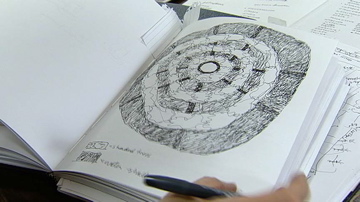Getting students into good habits early in the year, such as regularly working with sketchbooks and journals- in the classroom and at home, is a way to help students “mine” ideas, save developing ideas, and stay organized to create art that merges techniques learned with starting points that help define the larger story or inspiration behind their work. Sketchbooks can serve, as Marlene Dumas puts it, as “image banks”- places for students to store and organize images for later use.
Students in my introductory studio art class have used sketchbooks in the first two weeks of this year to organize experiments with different drawing media, take some initial notes about our upcoming work together, and begin a new unit that asks them to work with imagining possibilities and combining objects to form something entirely new. They are getting used to referring to their sketchbooks and jotting down possibilities. They’re also getting used to using the sketchbook for things other than what’s assigned in class. For the first time, a majority of my students are regularly using their sketchbook daily instead of storing it in the classroom when we’re not working together. This, as far as I can imagine, is largely due to reinforcing (A LOT) that the sketchbooks are theirs to design and develop. It’s not just a place for assigned work.
Season 4 artist Ursula von Rydingsvard and Season 3 artist Krzysztof Wodiczko both incorporate the use of sketchbooks to “mine” ideas and work through the planning stages of their large-scale works. Students can draw inspiration from these and other Art:21 segments as they actively look for evidence of planning and ways of planning.
How do you incorporate sketchbooks or journals in your classroom? If you’re not already doing so, what kinds of challenges do you face? How might sketchbooks be used in different ways?





Pingback: Mining Ideas Part 2: Using Sketchbooks to Help Teach About Contemporary Art | Art21 Blog
Pingback: Process and Power | Art21 Blog
Pingback: Best of the Art21 Blog, 2008 edition | Art21 Blog
Pingback: The Importance of Being Earnest | Art21 Blog
Pingback: Enjoying the Steps | Art21 Blog
Pingback: Teaching with Contemporary Art: The First Three Years | Art21 Blog